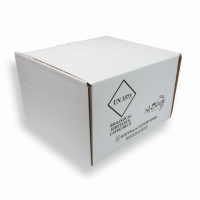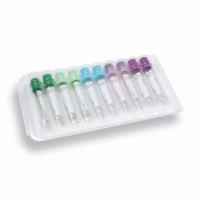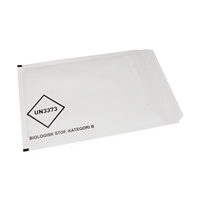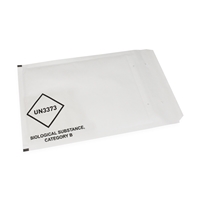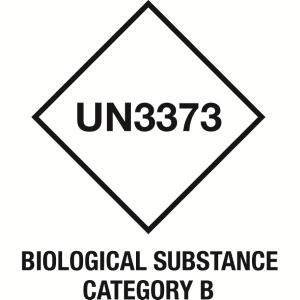Diagnostic specimens, assigned to UN 3373, are human or animal materials that are being transported only for the purpose of diagnosis or investigation. Such materials include excreta, blood and it's components, as well as other tissues and fluids. Diagnostic specimens do not include live infected animals.
Packaging requirements are at packing instruction P650.
If the source (the patient) is known to have a serious disease that can be readily transmitted and for which effective treatment and preventative measures are not usually available, then the substance must beassigned UN 2814 or UN 2900, as appropriate.
Indentified as:
- UN 3373
- Packaging instruction P650
Proper shipping name is: “Biological Substance, Category B”
Exemptions:
- Substances which do not contain infectious substances or substances which are unlikely to cause
disease in humans or animals are not subject to these Regulations unless they meet the criteria for inclusion in another class.
- Substances containing microorganisms which are non-pathogenic to humans or animals are not
subject to these Regulations unless they meet the criteria for inclusion in another class.
- Substances in a form that any present pathogens have been neutralized or inactivated such that
they no longer pose a health risk are not subject to these Regulations unless they meet the criteria for inclusion in another class.
NOTE: Medical equipment which has been drained of free liquid and meets the requirements of this
paragraph is not subject to these Regulations.
- Environmental samples (including food and water samples) which are not considered to pose a
significant risk of infection are not subject to these Regulations unless they meet the criteria for inclusion in another class.
- Dried blood spots, collected by applying a drop of blood onto absorbent material, or faecal occult
blood screening tests and blood or blood components which have been collected for the purposes of transfusion or for the preparation of blood products to be used for transfusion or transplantation and any tissues or organs intended for use in transplantation are not subject to these Regulations.
-Human or animal specimens for which there is minimal likelihood that pathogens are present are not subject to these Regulations if the specimen is transported in a packaging which
will prevent any leakage and which is marked with the words “Exempt human specimen” or “Exempt animal specimen”, as appropriate.
The packaging should meet the following conditions:
(a) The packaging should consist of three components:
(i) a leak-proof primary receptacle(s);
(ii) a leak-proof secondary packaging; and
(iii) an outer packaging of adequate strength for its capacity, mass and intended use, and with at least one surface having minimum dimensions of 100 mm × 100 mm;
(b) For liquids, absorbent material in sufficient quantity to absorb the entire contents should be placed between the primary receptacle(s) and the secondary packaging so that, during transport, any release or leak of a liquid substance will not reach the outer packaging and will not compromise the integrity of the cushioning material;
(c) When multiple fragile primary receptacles are placed in a single secondary packaging, they should be either individually wrapped or separated to prevent contact between them.
NOTE 1: An element of professional judgment is required to determine if a substance is exempt under this paragraph. That judgment should be based on the known medical history, symptoms and individual circumstances of the source, human or animal, and endemic local conditions. Examples of specimens which may be transported under this paragraph include the blood or urine tests to monitor cholesterol levels, blood glucose levels, hormone levels, or prostate specific antibodies (PSA); those required to monitor organ function such as heart, liver or kidney function for humans or animals with non-infectious diseases, or for therapeutic drug monitoring; those conducted for insurance or employment purposes and are intended to determine the presence of drugs or alcohol; pregnancy test; biopsies to detect cancer; and antibody detection in humans or animals in the absence of any concern for infection (e.g. evaluation of vaccine induced immunity, diagnosis of autoimmune disease, etc.).
NOTE 2: For air transport, packagings for specimens exempted under this paragraph shall meet the conditions in (a) to (c).
Except for:
(a) Medical waste (UN 3291);
(b) Medical devices or equipment contaminated with or containing infectious substances in Category A (UN 2814 or UN 2900); and
(c) Medical devices or equipment contaminated with or containing other dangerous goods that meet the definition of another hazard class, medical devices or equipment potentially contaminated with or containing infectious substances which are being transported for disinfection, cleaning, sterilization, repair, or equipment evaluation are not subject to the provisions of these Regulations if packed in packagings designed and constructed in such a way that, under normal conditions of transport, they cannot break, be punctured or leak their contents. Packagings shall be designed to meet the construction requirements.
These packagings shall meet the general packing requirements and be capable of retaining the medical devices and equipment when dropped from a height of 1.2 m. For air transport, additional requirements may apply.
The packagings shall be marked “USED MEDICAL DEVICE” or “USED MEDICAL EQUIPMENT”. When using overpacks, these shall be marked in the same way, except when the inscription remains visible.
Reference: WHO (updated June 2018)


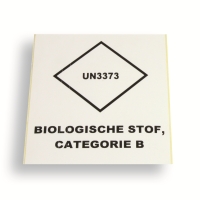
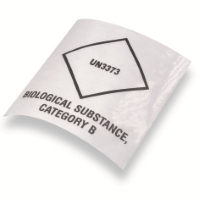



620_P(I)650-complete-set-cooled-White.jpg)
-White.jpg)
